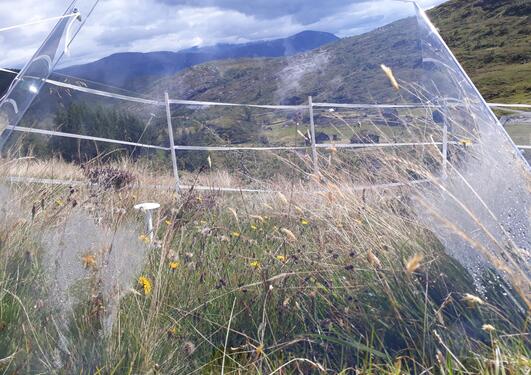Montane species range expansion
Vigdis Vandvik, Nadine Arzt

Main content
Establishment success of range-expanding species in a montane grassland
As both native and exotic species shift their distributions in response to climate warming and through biological invasions, many expand their ranges across elevational gradients. This expansion results in the reassembly of ecological communities, which mediates the effects of climate warming on biodiversity and key ecosystem functions. RangeX is a multidisciplinary, replicated field and laboratory experiment being conducted in climatically and socio-ecologically contrasting regions (Switzerland, Norway, China, South Africa) that seeks to better understand these range shifts in mountain habitats. Mountains are of crucial conservation value as hotspots of biodiversity, refugia for biota threatened by climate warming, and as key global sources of water, food, and livelihoods, but are experiencing above-average rates of warming and increasing pressures from invasive species and development, making mountains priority areas for sustainability research.
Experimental design: RangeX field experiments comprise warming treatments, introduction and removal of key plant species, and intensive monitoring of soils, plants, and pollinators across multiple elevations. By investigating biotic interactions both above and below ground, we aim to: (i) disentangle the drivers of range expansions; (ii) uncover the consequences of range-expanders on biodiversity and ecosystem functioning; and (iii) predict the extent and impacts of future range expansions. Location: montane and lowland grasslands near Voss, Norway.
Question: Can lowland grassland species successfully establish in a montane setting?
Methods: Our current experimental set-up looks at the drivers and impacts of range-expanding plants by monitoring vital rates and functional traits of transplanted seedlings of lowland species in a mountain valley. Yet this does not allow us to test whether these plants are able to establish themselves via seeds. This can be investigated with an in-situ germination experiment using seeds. Seeds of our ten focal species will be sown within our established plots, where we can document seed germination success as a response to various treatments (e.g. artificial warming using open-top chambers (OTCs)). Data on germination rates and seedling traits will be valuable in parsing factors that drive the success/failures of range-expanding plants.
As an MSc student working within the RangeX project, you will:
- Do field work, and learn how to design and conduct ecological experiments, identify and measure plants and/or insect pollinators, manage and analyze ecological data, write it up as a thesis, and present your work in oral presentations within the team and at conferences.
- Be part of the ‘Between The Fjords’ lab group activities
- Be part of a large collaborative international research project, where you will participate in project meetings and workshops online and in person.
- Get to know and work with a cross-disciplinary group of researchers at different career stages, and see how your work relates to work on different functional groups and trophic levels.
- Be given opportunities to present your work at scientific conferences, and you will be supported in publishing your thesis as a scientific article.
We have listed multiple project options on this website, but if you have other suggestions, don’t be afraid to contact us and ask!

